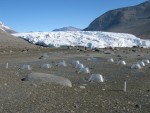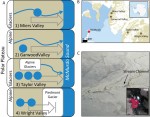In 2011, the McMurdo Dry Valleys LTER enters its fourth funding cycle with several new PIs and a focus on the theme of ecological connectivity. Building on eighteen years of LTER activity in this polar desert, the MCM IV research will investigate how the Dry Valley ecosystem will respond to the future climate warming that is predicted in East Antarctica. The McMurdo Dry Valleys can be thought of as a “mosaic of interconnected landscapes,” and as a consequence of climate warming these interconnections are likely to intensify.
The past decade has witnessed three summers of unusually high temperatures and strong katabatic winds in the Dry Valleys leading to so-called “flood years” of unusually high glacial melt. As East Antarctica is expected to heat up in response to a recovery of the Ozone hole over Antarctica and global warming, the occurrence of warmer, windier summers is expected to increase, driving an increase in “pulse events” such as high stream flows and lake flooding.
MCM IV sets out to examine contemporary patterns in ecological connectivity to use as a basis for predictions of future change. Its overarching hypothesis is that “climate warming in the MDV ecosystem will amplify connectivity among landscape units leading to enhanced coupling of nutrient cycles across landscapes, and increased biodiversity and productivity within the ecosystem.” Since the beginning of the MCM LTER, the Taylor Valley – which contains Lakes Bonney, Hoare, and Fryxell – has been the center of research activity. Predictions suggest that climate warming in the Taylor Valley will cause lakes in the closed basins to rise and possibly coalesce. To further understand these changes, MCM IV will extend its geographical scope to include the nearby Miers and Garwood Valleys, where streams already discharge into the coastal bays and thermocarst erosion is already underway (See map 1 or Figure 1).
In addition to expanding the geographical scope of the MCM LTER site, a number of new experiments and monitoring programs will be introduced to test the four sub-hypotheses included in the proposal. In order to examine the response of wind borne particles to enhanced connectivity from katabatic winds, for example, MCM IV monitoring will measure aeolian material fluxes using automated acoustic particle counters. One of the new experiments will augment soil moisture through a prolonged diversion of stream water onto larger plots than in the past. This experiment will be used in the hydrologic modeling of soil connections to streams and lakes and will help to define habitat suitability during increasing connectivity caused by climate change. In another new development, MCM IV will increasingly integrate metagenomics across its activities.
MCM IV adds four new PIs to the group from MCM III. Joining the PI team are Jeb Barrett, Byron Adams, Cristina Takacs-Vesbach, and Adrian Howkins, an environmental historian at Colorado State University. Mike Gooseff became a PI towards the end of MCM III. Since September 2009, Diane McKnight has been the lead PI of the MCM LTER, and the management office is located at the Institute of Arctic and Alpine Research at the University of Colorado in Boulder.
Dr. Jeb Barrett is a soil ecologist and biogeochemist at Virginia Tech. His research in Antarctica has focused on the climatic and geochemical controls over the distribution and activity of soil biota and biogeochemical connectivity between aquatic and terrestrial ecosystems. As part of MCM IV Barrett and other LTER scientists will be re-routing melt water through dry soil environments to simulate the influence of increased melt and hydrological connectivity on solute mobilization, soil biota, and permafrost dynamics. Other work includes experiments testing the influences of landscape history on nutrient cycling and the influence of climate variation on soil communities.
Dr. Byron Adams is an evolutionary biologist at Brigham Young University. He focuses his efforts on the MCM meiofauna – primarily nematodes, but also tardigrades and rotifers. He uses inferences from molecular systematics and population genetics to explore patterns of biological connectivity across the different MCM landscape units. He also is interested in stoichiogenomics, and using ecological genomics tools to identify evolutionary responses to environmental changes.
Dr. Cristina Takacs-Vesbach is a molecular microbial ecologist at the University of New Mexico, Albuquerque. Her research in Antarctica is focused on discovering the diversity and ecological function of Bacteria and Archaea in the McMurdo Dry Valleys. During MCMIV, Takacs-Vesbach will exhaustively survey microbial diversity across the dry valley landscape and use metagenomics to determine the metabolic potential and function of microbial communities. Changes in microbial community composition and function will be examined in response to increased moisture and nutrient through experiments to be conducted in coordination with the other members of the team. In addition, Takacs-Vesbach will now oversee the MCM information management system, which will be transferred to UNM during 2011.
Dr. Mike Gooseff's research in the Dry Valleys began in his dissertation work, which focused on modeling stream hyporheic exchange and biogeochemistry. Since then he has studied land-water interactions and the influence of snow on soil microbiology and biogeochemistry. He is currently developing conceptual and numerical models of the MCM ecosystem built upon physical understanding of energy and mass movement.
Dr. Adrian Howkins is an environmental historian at Colorado State University. He is currently completing a book on the environmental history of the Antarctic Peninsula. As part of MCM IV, Howkins will be carrying out a social science project that will investigate the environmental history of the McMurdo Dry Valleys since they were first sighted by the famous explorer Captain Scott in 1903. The project proposes that in much the same way as the simplicity of the Dry Valley ecosystems makes the area an ideal location for exploring ecological theory, the relative simplicity of the area’s human history makes it an excellent location for thinking about human interactions with the natural world over time. This project will connect with social science work at other LTER sites, and will also offer opportunities to link with developing arts and humanities activities across the LTER network.
MCM IV will continue its outreach activities, with several new developments. The Schoolyard LTER Lost Seal book, for example, will be translated into Spanish with the addition of new material and artwork from schoolchildren in Argentina, Chile, Mexico, and Spain. Maintaining the the Antarctic tradition of international collaboration, MCM scientists will continued to make important contributions to the international Antarctic community, through such organizations as the Scientific Committee on Antarctic Research (SCAR). The beginning of MCM IV is an exciting time for everyone connected to the site, and the team looks forward to sharing their results with the LTER community over the next few years.

 Enlarge this image
Enlarge this image
